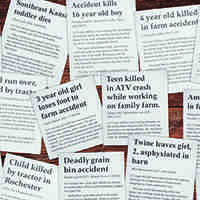
Every 3 days, a child dies in an agriculture-related incident.
 “Two-year-old Idaho boy dies after run over by tractor.”
“Two-year-old Idaho boy dies after run over by tractor.”
“Passenger fatally injured when the UTV operated by a 17 y/o male rolled over.”
News stories such as these are too common. Rural America is a great place to grow up, but it has its inherent dangers. That is especially true in a farming community where hazards are present in daily life. Research is pointing to three groups where we can save lives and prevent injuries:
- Children and youth living on the farm.
- Youth hired for farm work.
- Children and youth visitors (family, friends, and agro-tourism).
There are many jobs on the farm that children and youth can perform safely. The updated Youth Work Guidelines available from the National Children’s Center for Rural and Agricultural Health and Safety (NCCRAHS) is a practical tool for parents to use in assessing child readiness. For younger children, parents should designate a safe play area separate from the worksite and supervise their activities. See the full booklet or mini-booklets, Creating Safe Play Areas on Farms, in English or Spanish available from the Resource Library at the NCCRAHS.

PNASH surveys Latino family farmers
The Latino workforce is essential to our Northwest agricultural communities, yet there are few Spanish language resources for families about children's farm safety. To understand our local needs, Maria Tchong-French led a small voting-booth survey in Spanish at Ag Safety Day in Wenatchee. Results showed that operating a lawn mower was the most common task for adolescent workers. The top two areas of interest were chemical safety and building safe play areas. We hope to find other opportunities to conduct the voting-booth activity and further understand Latino family farm needs. For questions, please email or call (800) 330-0827.
How can you help?
In addition to the actions you can take on your own farm, for kids working on the farm and visiting, you can champion farm safety through your community and networks. See the resources and organizations below to share information and get involved.
RECOMMENDED SAFETY RESOURCES
Resources for Children:
Please review the resources below, take the trainings offered, and share this information with others. Your actions could help save a life.
Aunque Cerca, Sano - Una guía de prevencíon de los riesgos de pesticidas - Spanish.
CultivateSafety.org - A one-stop resource for children safety information, including:
- Child Agricultural Safety Brochure,
- 2020 Child Agricultural Injury Fact Sheet
- Safety Guidelines for Hired Adolescent Workers (English and Spanish),
- Safe Play Areas (English and Spanish),
- A Guide to Help Dairy Workers (English and Spanish), and
- Many other child safety brochures.
Keeping Pesticides on the Farm - Online Course.
Marshfield Research - Childcare in Agriculture.
National Ag Safety Database - Child Safety Materials.
Resources for Hired Youth Work Guidelines:
Published November 2023, the Hired Agricultural Youth Work Guidelines Resources (HAYWG) helping farm employers and supervisors reduce the risk of injury to young workers. HAYWG provides guidance for training and supervising young workers including regulation information with tip sheets for safety guidelines for youth performing common farm tasks. HAYWG doesn't replace the Agricultural Youth Work Guidelines (AYWG). The two resources should be used in combination.
Resources for Hired Youth or Teen Ag Workers:
Ag in the Classroom Curriculum - Health and Safety Awareness for Working Teens in Agriculture.
Agricultural Youth Work Guidelines - Easy to use safety information about age-appropriate farm activities.
Model Policy - Youth Employment in Agriculture - Great resources here.
Safety in Agriculture for Youth (SAY) Project - Resources on health and safety curricula for youth working in agriculture.
Virtual Tractor Inspection Training Tool - Online Course.
Washington Department of Labor & Industry, Accident Prevention Program (APP) in Agriculture.
Washington Department of Labor & Industry, Injured Young Workers Speakers Program - “Matt Pomerinke of Longview, Washington was just 21 and working at a lumber mill when his arm was caught in an unguarded conveyor drive chain and ultimately amputated just below the elbow.”
Working with Youth Guideline Booklets - Safety Guidelines for Hired Adolescent Farm Workers (SaGHAF) available in English, Spanish, and French.
U.S. Department of Labor, OSHA, Youth in Agriculture eTool describes common agricultural hazards and offers potential safety solutions for employers and workers to prevent accidents and avoid injury at work.
Fun activities for Youth and Teens:
Meet the Flat Farmers from The Great Plains Center for Agricultural Health. The Flat Farmers are a hand-on educational tool designed to teach personal protective equipment (PPE). The tool includes a set of four farmers (two male- and two female-presenting) with an array of clothing and PPE options to protect them.
Empowering Aussie Teens with Farm Safety Knowledge from Calm Your Farm. A free to play farm injury prevention and safety educational game develop by high schoolers, for schoolers.
AgINJURY NEWS
AgInjuryNews.org - Sign-up to receive custom email alerts / or help track cases about agriculture-related incidents reported in your region to help spread the word about injury prevention. Learn more.
2022 Childhood AgInjury Fact Sheet - Childhood Agricultural Injuries.
ESSENTIAL ORGANIZATIONS
You can get involved in local and national youth safety promotion and education.
Children’s Agricultural Safety Network - The Childhood Agricultural Safety Network (CASN) is a coalition of organizations that keeps children safe on the farm. Visit their website to find educational materials and webinars. Learn more.
National Children’s Center for Rural and Ag Health and Safety - The National Children’s Center leads the country in protecting working and non-working farm youth through research, outreach, and prevention. Learn more.
Progressive Agriculture - This educational program provides training and resources for local communities to conduct one-day safety and health programs called Safety Days. These programs are designed to be age-appropriate, hands-on, fun, and safe for children. Champions for Northwest community events are needed! Learn more.
